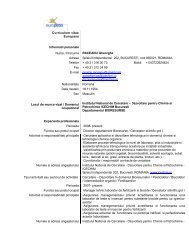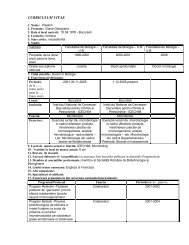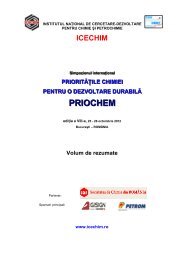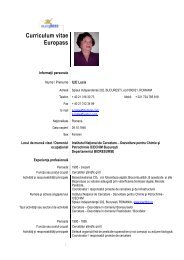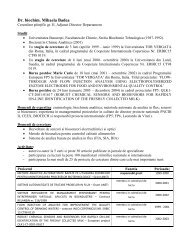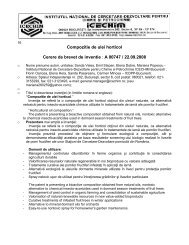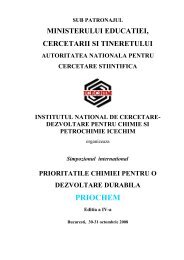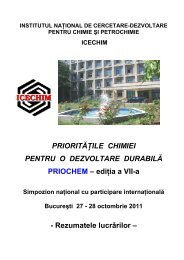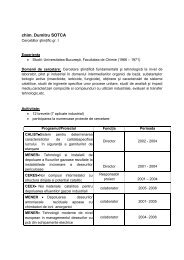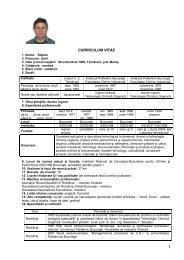Biomasa este un termen generic care cuprinde o ... - ICECHIM
Biomasa este un termen generic care cuprinde o ... - ICECHIM
Biomasa este un termen generic care cuprinde o ... - ICECHIM
You also want an ePaper? Increase the reach of your titles
YUMPU automatically turns print PDFs into web optimized ePapers that Google loves.
94Results. The t<strong>este</strong>d photosensitizers are not toxic at concentrations lower than 20microg/ml and accumulate in the intracitoplasmic compartments as proven by fluorescencemicroscopy. K562 loaded with the mentioned compo<strong>un</strong>ds and subjected to irradiation displaylower proliferative capacity and higher caspase 3 activity that correlates with an increase in theDNA fragmentation. The photodynamic kinetics of cell suspensions show that duringirradiation, tumor cells are actively destroyed comparatively with <strong>un</strong>loaded tumor cells. Earlyapoptotic events are not significantly different compared with the control suggesting that theprocess has evolved during irradiation to the effector phases of apoptosis.Grant supported by Viasan Project Nr.228/20033. NATURAL AND SYNTHETIC SENSITIZERS FOR CLINICAL PHOTODYNAMICTHERAPY OF CANCERRodica-Mariana Ion<strong>ICECHIM</strong>, 202-Splaiul Independentei, 060021-Bucharest, RomaniaPhotodynamic therapy (PDT) is an emerging field that uses light-activated drugs toproduce specific biological effects in cells and tissues. Its particular strengths arise from theability to spatially localize the biological responses by the way the light is applied; the range ofpossible mechanisms of action at the cell, tissue, and organism levels; and the combination ofnovel molecular and optical technologies. Photosensitizers in photodynamic therapy are thevessels that allow for the transfer and translation of light energy into a type II chemicalreaction. The reactive end products of this pathway results in a rapid cyto and vasculo toxicitywhich are the sine qua non of photodynamic therapy. In clinical practice, photosensitizers arisefrom three families – porphyrins, chlorophylls, and dyes. All clinically successfulphotosensitizers have the ability to a greater or lesser degree, to target specific tissues or theirvasculature to achieve ablation. Each photosensitizer needs to reliably activate at a high enoughlight wavelength useful for therapy. Their ability to fluoresce and visualize the lesion is abonus. Photosensitizers developed from each family have <strong>un</strong>ique properties that have so farbeen minimally clinically exploited 1 . This review looks at the potential benefits andconsequences of each major photosensitizer that has been tried in a clinical setting. Recently,numerous efforts have been made in searching for new and more effective photosensitizingagents (second-generation agents) that have the following characteristics to improve PDTapplication: low toxicity in the dark, preferential accumulation in tumor tissue, good watersolubilityfor the administration of aqueous solutions, and high absorption in the therapeutic



